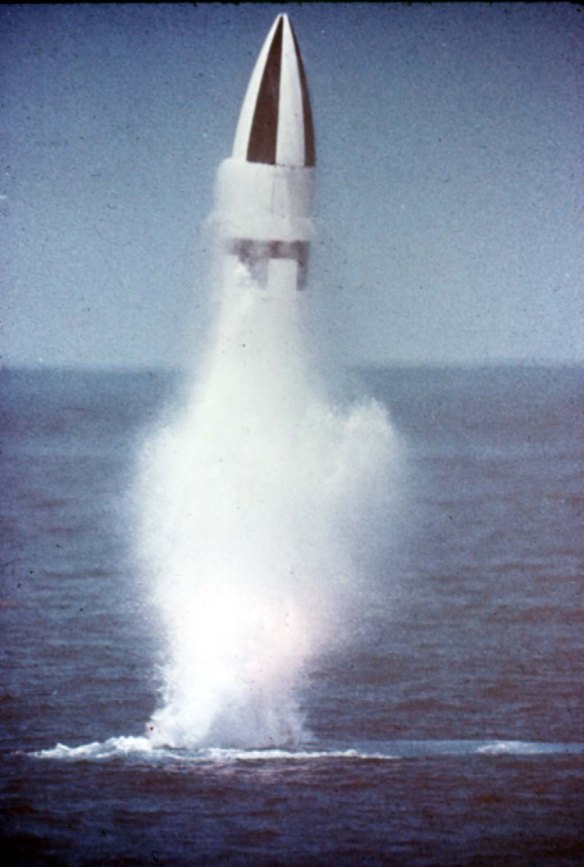Polaris, named after the North Star, was a two-stage ballistic missile powered by solid-fuel rocket motors and controlled by a self-contained inertial guidance system. It was designed to be launched from a submerged submarine. On July 20, 1960, Polaris became the first ballistic missile to be launched from a submarine under water. (In 1942, Germany had successfully test-fired mortar rounds from partially submerged mortar tubes, but no missile had ever been launched from a submerged submarine.) A second A1 Polaris missile was fired three hours later, demonstrating that multiple wartime missile launches were feasible. The Polaris program was the culmination of an intensive four-year program by the Department of the Navy.
There were three versions of the Polaris, designated A1, A2, and A3. Each modification of the missile improved its range, accuracy, target flexibility, and throw weight. Polaris was launched from three classes of fleet ballistic missile nuclear-propelled submarines (SSBNs): the George Washington class, the Ethan Allen class, and the Lafayette class. The first Polaris A2 launch occurred on October 23, 1961, and the first Polaris A3 launch took place on October 26, 1963. Polaris A1 had an initial range of 1,200 nautical miles, and the A2 missile had a range of 1,500 nautical miles. Polaris A1 and A2 carried a single nuclear warhead, and the Polaris A3 carried multiple but not independently targetable warheads. On May 6, 1962, a nuclear-armed Polaris A1 was launched from the USS Ethan Allen while submerged in the Pacific, and its nuclear warhead was detonated over the South Pacific on target. This 1962 launch and nuclear weapon detonation remains the only complete proof test of a U. S. strategic missile ever conducted. The A2 missile became operational in 1962 when it was first deployed on the USS Ethan Allen. The A1 missile was retired in 1965, and the A2 was retired from service in 1974.
The Polaris A3 represented a significantly greater technological advance over Polaris A2, and with an approximately 85 percent new design, it was practically an entirely new missile. With a range of 2,500 nautical miles, it had the ability to reach any land target on the Earth. It also was the only Polaris missile to be equipped with multiple (three) reentry bodies, which were initially intended to serve as a way to penetrate primitive Soviet missile defenses. The first flight test of the A3 was conducted in August 1962, and the A3 became operational in September 1964 when the USS Daniel Webster began its initial operational patrol with sixteen A3s aboard. All Polaris A3 missiles were retired by the U. S. Navy when the last U. S. Polaris SSBN offloaded in February 1982.
The term “Polaris” also is used to describe the submarine on which the Polaris ballistic missiles were deployed. The Polaris submarine was 380 feet long with a 33-foot beam and weighed 6,700 tons. It was designated the 598 class and later the 608 class. There were five submarines in each class. The last Polaris A3 SSBN was reclassified as a nonstrategic submarine and eventually retired from service in 1983.
References Dicerto, Joseph, Missile Base beneath the Sea: The Story of Polaris (New York: St. Martin’s Press, 1967). Spinardi, Graham, From Polaris to Trident: The Development of U. S. Fleet Ballistic Missile Technology (New York: Cambridge University Press, 1994). “Submarine Launched Ballistic Missiles,” from United States Nuclear Forces Guide, Federation of American Scientists, available at http://www.fas.org/nuke/ guide/usa/slbm.
